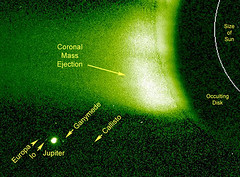Now, as an astronomer I have to tell you: don’t stare at the Sun.
That’s because you should let NASA do that for you. When they do it, they get to see cool stuff like this:
That’s a pretty nifty animation (direct links to better quality movies: mov, hi res mov, and mpg) from NASA’s STEREO B spacecraft, currently orbiting the Sun. It shows Jupiter, with its four big moons easily visible, as it drifts behind the Sun from the spacecraft’s viewpoint. In the animation you can actually see the motion of the moons as they orbit Jupiter, too. Plus, as a bonus, a coronal mass ejection can be seen apparently gently streaming away from the Sun. Don’t be fooled, though: that is a huge blast of energy off the Sun, propelling billions of tons of plasma away from the solar surface at hundreds of thousands of kilometers per hour.
 |
| Annotated still from the animation. Click to embiggen. |
STEREO has an occulting disk, literally a piece of metal that blocks the bright sunlight so that it can see the fainter wispy CMEs and normal solar corona (the dotted circle represents the size of the disk of the Sun). At the end of the animation you can see Jupiter slip behind the occulter. At some point this year, Saturn will play this same game, slipping past the Sun as seen by STEREO. I hope they catch that as well. I’m still looking for Top Ten Pictures for this year, too!
Image credit: NASA/STEREO